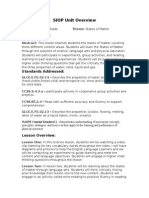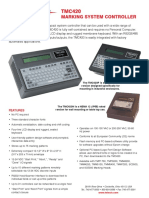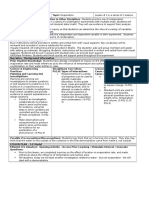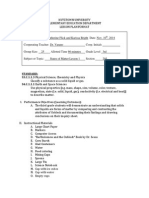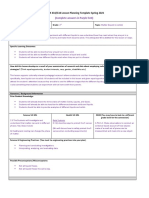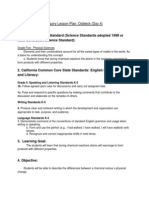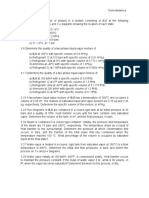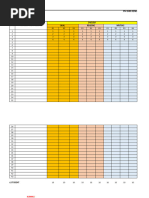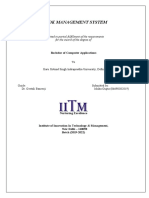Instructional Project 4 1 1
Instructional Project 4 1 1
Uploaded by
api-582677663Copyright:
Available Formats
Instructional Project 4 1 1
Instructional Project 4 1 1
Uploaded by
api-582677663Original Title
Copyright
Available Formats
Share this document
Did you find this document useful?
Is this content inappropriate?
Copyright:
Available Formats
Instructional Project 4 1 1
Instructional Project 4 1 1
Uploaded by
api-582677663Copyright:
Available Formats
INSTRUCTIONAL PROJECT 4
1) Date: 04/23/24
Teacher: Ms. Munira N
2)Lesson: The States of Matter
Lesson Type: Daily lesson plan
3) Grade: 4th
Subject: Physical science
4) Timeline: about 45 minutes
5) Standards: Students investigate matter's measurable properties, including mass, volume,
states, temperature, magnetism, and relative density, to determine how it is classified.
6) Instructional Objectives: The student is expected to:
(A) classify and describe matter using observable physical properties, including temperature,
mass, magnetism, relative density (the ability to sink or float in water), and physical state (solid,
liquid, gas).
7) Materials: 3-5 samples each of a solid, liquid, and gas for students to work with. (The total
should be enough for each pair of students.)
Prepare ahead of time: Samples of solids could be blocks of wood, fabric, metal, glass, plastic,
etc. Liquids could include coffee, juice, milk, honey, etc. Gas could include soda (carbonation),
moth balls, empty containers to represent air, etc.
A chart/worksheet for students to write specific observations and measurements.
Water (add food coloring), ice cubes (use Kool-Aid cubes if possible), method to show water
(add something to the water to create an odor) boiling or condensation on the outside of a cold
glass, apple sauce or jelly.
Various measuring tools according to the attributes like thermometer, pan balance, digital
weighing scale, magnets, graduated cylinders, and measuring cups.
8) Introduction:
Bell work: Students will make a list of 5 items that they use in their daily life available in various
states of matter.
Opening activity or Hook: (Whole group)
Display the bottle of water, ice cubes, and boiling water (or show condensation) for
students to observe using only their 5 senses.
Once all are seated, ask students to share their observations.
Write all answers on the board.
9) Instructional Activities and Procedures:
After 5 – 7 minutes, discuss the differences and what makes them a solid, liquid, or
gas.
Pair the students in small groups of 4 or 5.
Introduce students to the items they will be working with.
Distribute prepared worksheets to each student for recording observations.
Stress the importance of making clear specific observations.
Show examples of the good data record sheet.
Ask students to use the provided tools to measure the listed attributes of each matter.
For example, measure the volume of water, use a magnet to check for magnetism
properties.
Supervise and ask ongoing questions to the students while they are working to check
for understanding.
10) Modifications:
Struggling Students: Students will be provided examples to which they can match to identify the
states of matter. For example, a picture of an ice cube named solid will be provided. The student
will match the real ice cube to the picture to identify the state of matter.
Advanced Students:
Students can work alone walking around the room to observe items on display. Then
students will go outdoors and pick items randomly to measure and observe the listed
attributes using the same tools.
Students can decide which of the items can be changed into a different state; solids used
in liquids (Kool-Aid, pulp), and provide other questions for reflection.
11) Evaluation and Assessment: the data record sheet be used to assess understanding of the
content.
Exit Ticket: Students will answer a question: What are the three states of matter and name to
measurable attributes that help differentiate them.
12. Resources: https://www.teacher.org/lesson-plan/the-united-states-of-matter/
You might also like
- The Way of The Dream (1987)Document392 pagesThe Way of The Dream (1987)Supriya Kalbag100% (1)
- CASE 580 SUPER M PARTS CATALOG (1) 580 M PDFDocument894 pagesCASE 580 SUPER M PARTS CATALOG (1) 580 M PDFjwd95% (20)
- Doom Metal Band Tuning Guide v1.0Document6 pagesDoom Metal Band Tuning Guide v1.0Pablo Alejandro Cerda SeverinoNo ratings yet
- Science 5 Activity Sheets v1.0Document49 pagesScience 5 Activity Sheets v1.0Herminia Diloy67% (3)
- Siop UnitDocument14 pagesSiop Unitapi-273446670100% (1)
- 5 e Model - Lesson Plan Template - Thematic Assignment - States of Matter LessonDocument12 pages5 e Model - Lesson Plan Template - Thematic Assignment - States of Matter Lessonapi-338294264100% (2)
- Lesson Plan Matter and EnergyDocument5 pagesLesson Plan Matter and Energyapi-281819463No ratings yet
- Telesis TMC420 08Document1 pageTelesis TMC420 08Mahmoud Singer0% (1)
- Lesson PlansDocument10 pagesLesson Plansasma amjadNo ratings yet
- Design Topic Matter Subject(s) Science Grade(s) 2 Designer(s) Brinda Patel Understanding by DesignDocument9 pagesDesign Topic Matter Subject(s) Science Grade(s) 2 Designer(s) Brinda Patel Understanding by Designapi-308490271No ratings yet
- Grade LevelDocument2 pagesGrade Levelyasserkadatuan48No ratings yet
- 5e Science Lesson Plan HixsonDocument7 pages5e Science Lesson Plan Hixsonapi-675793527No ratings yet
- Lesson 1Document5 pagesLesson 1api-264643152No ratings yet
- Portfolio Standard 1 - Matter Unit Day 3 LessonDocument4 pagesPortfolio Standard 1 - Matter Unit Day 3 Lessonapi-313166146No ratings yet
- Developmental Lesson PlanDocument5 pagesDevelopmental Lesson Planapi-339309940No ratings yet
- Particle Model of Solids, Liquids and Gases: Unit GuideDocument122 pagesParticle Model of Solids, Liquids and Gases: Unit GuideVithyia MurugiahNo ratings yet
- Ethangreen 18498515 1a Sequenced LessonsDocument31 pagesEthangreen 18498515 1a Sequenced Lessonsapi-552869059No ratings yet
- FSA Department UDL Lesson Plan FormatDocument4 pagesFSA Department UDL Lesson Plan Formatapi-623580840No ratings yet
- Science Program Term 2 - Year 3Document20 pagesScience Program Term 2 - Year 3nicole.vieira2No ratings yet
- Science Day5Document4 pagesScience Day5api-339309940No ratings yet
- States of Matter Lesson PlanDocument4 pagesStates of Matter Lesson Planapi-252742039No ratings yet
- Devens SciencelpDocument5 pagesDevens Sciencelpapi-282221666No ratings yet
- 5e Lesson Plan 26-29 OctoberDocument3 pages5e Lesson Plan 26-29 Octoberapi-295547670100% (1)
- Science Whole Group Inquiry Lesson Plan 2Document7 pagesScience Whole Group Inquiry Lesson Plan 2api-379957585No ratings yet
- Unit Overview Ees440Document4 pagesUnit Overview Ees440api-294097634No ratings yet
- Unit Plan Why Matter Matters 3 Grade Science: LessonsDocument17 pagesUnit Plan Why Matter Matters 3 Grade Science: Lessonsapi-210754277No ratings yet
- Science Udl Lesson 1Document5 pagesScience Udl Lesson 1api-238637442100% (1)
- Completed Science Lesson 1Document6 pagesCompleted Science Lesson 1api-264121817No ratings yet
- Science Lesson PlanDocument11 pagesScience Lesson Planapi-292046301No ratings yet
- Changes in Matter Lesson 2 205 EditedDocument6 pagesChanges in Matter Lesson 2 205 Editedapi-264121817No ratings yet
- LEARNING PLAN LOADINGsDocument6 pagesLEARNING PLAN LOADINGsgargoleslianNo ratings yet
- Sample Instructional Project 4Document3 pagesSample Instructional Project 4api-583068177No ratings yet
- Evaporation Condensation and Melting 1Document6 pagesEvaporation Condensation and Melting 1api-300813801No ratings yet
- 5e Lesson Plan 20 22 OctoberDocument3 pages5e Lesson Plan 20 22 Octoberapi-295547670100% (2)
- Melting and Freezing ReviewDocument10 pagesMelting and Freezing Reviewapi-300813801No ratings yet
- Matter Unit PlanDocument8 pagesMatter Unit Planapi-271760348100% (1)
- EGE 1 Lesson PlanDocument3 pagesEGE 1 Lesson PlanJohn inri RomanNo ratings yet
- Lesson - Plan Science 4 Q1Document5 pagesLesson - Plan Science 4 Q1Ivy Lynn AmarilleNo ratings yet
- Stem 534 Lesson PlanDocument7 pagesStem 534 Lesson Planapi-710456380No ratings yet
- Lesson Plan in ScienceDocument14 pagesLesson Plan in ScienceAlren SaberonNo ratings yet
- Scavenger Hunt Lesson PlanDocument3 pagesScavenger Hunt Lesson Planapi-258318298No ratings yet
- Harrison Mikayla-Lessonplan1finalDocument9 pagesHarrison Mikayla-Lessonplan1finalapi-644095413No ratings yet
- Mackenzie Davis 3rd Grade, Science Matter (Solid, Liquid, and Gas)Document7 pagesMackenzie Davis 3rd Grade, Science Matter (Solid, Liquid, and Gas)api-313400286No ratings yet
- Student Teaching Edtpa Indirect Instruction Lesson Plan TemplateDocument2 pagesStudent Teaching Edtpa Indirect Instruction Lesson Plan Templateapi-301113011No ratings yet
- Science LPDocument4 pagesScience LPapi-271280013No ratings yet
- Matter-Properties of SolidsDocument3 pagesMatter-Properties of Solidsapi-221536319No ratings yet
- EDT 415 Lesson PlanDocument6 pagesEDT 415 Lesson PlanAnonymous POu2y6No ratings yet
- Lesson Plan - Science Yr 3 - Whats The Matter (Repaired)Document3 pagesLesson Plan - Science Yr 3 - Whats The Matter (Repaired)Elise BradyNo ratings yet
- Schellenberg Portfolio 4 Di Strategies Science LessonDocument4 pagesSchellenberg Portfolio 4 Di Strategies Science Lessonapi-240543137No ratings yet
- Assignment OneDocument45 pagesAssignment Oneapi-355627407No ratings yet
- Classify Materials Based On Their Ability To Absorb Water, Float, Sink, or Undergo Decay.Document5 pagesClassify Materials Based On Their Ability To Absorb Water, Float, Sink, or Undergo Decay.charissedatuonNo ratings yet
- Bird Kaitlin Lesson PlanDocument3 pagesBird Kaitlin Lesson Planapi-317410198No ratings yet
- SCIENCE Sample Lesson PlanDocument11 pagesSCIENCE Sample Lesson Planreasales2573No ratings yet
- Jessicanelson Lessonplan5 Assignment1Document6 pagesJessicanelson Lessonplan5 Assignment1api-397018670No ratings yet
- NST Lesson PlanDocument3 pagesNST Lesson PlansnespellmanNo ratings yet
- Standard III Lesson 1Document4 pagesStandard III Lesson 1api-140643650No ratings yet
- Lesson Plan No 4Document6 pagesLesson Plan No 4hafeez ahmedNo ratings yet
- lesson_plan (2)Document5 pageslesson_plan (2)Clarence BautistaNo ratings yet
- Lesson 3Document3 pagesLesson 3api-248372922No ratings yet
- ScienceunitDocument5 pagesScienceunitapi-242352797No ratings yet
- Lesson Plan ScienceDocument3 pagesLesson Plan ScienceHanz AbejuelaNo ratings yet
- Solid Liquid GasDocument7 pagesSolid Liquid Gasapi-431673822No ratings yet
- Elementary Science Experiments: Analyzing Data to Make PredictionsFrom EverandElementary Science Experiments: Analyzing Data to Make PredictionsNo ratings yet
- 10 Science Lesson Plans for KS1 - Volume 1: Sorting and Using MaterialsFrom Everand10 Science Lesson Plans for KS1 - Volume 1: Sorting and Using MaterialsNo ratings yet
- @piratedstudy: Get Our Special Grand Bundle PDF Course For All Upcoming Bank ExamsDocument36 pages@piratedstudy: Get Our Special Grand Bundle PDF Course For All Upcoming Bank ExamsCrack ItNo ratings yet
- GEOVIA Minex v6.5.293.0 x64 Software Download: Home Home Software Graphic SoftwareDocument4 pagesGEOVIA Minex v6.5.293.0 x64 Software Download: Home Home Software Graphic SoftwareTri BudiNo ratings yet
- CH 9-Life in Temperate Grasslands COMPILEDDocument49 pagesCH 9-Life in Temperate Grasslands COMPILEDmitaNo ratings yet
- Wings - X - Orangutan Phantom User ManualDocument1 pageWings - X - Orangutan Phantom User ManualTulsiNo ratings yet
- DeforestationDocument22 pagesDeforestationNachiket DeshpandeNo ratings yet
- 3 Sem MetallurgyDocument12 pages3 Sem MetallurgySuraj KumarNo ratings yet
- SwethaDocument8 pagesSwethamuppala gowthamNo ratings yet
- Tarea 4 TermodinamicaDocument3 pagesTarea 4 TermodinamicaMario GonzalezNo ratings yet
- 11 Basics and Polygons Question BankDocument3 pages11 Basics and Polygons Question BankmanojNo ratings yet
- Functional Document for Perfume Sales Mobile AppDocument3 pagesFunctional Document for Perfume Sales Mobile Appaunsheikh100No ratings yet
- Nek 6214 ZDocument3 pagesNek 6214 ZAmir KhosroabadiNo ratings yet
- To Be Present ExercisesDocument5 pagesTo Be Present ExercisesRichardNo ratings yet
- Phase-I: Select Your Desired Scholarship ProgramDocument3 pagesPhase-I: Select Your Desired Scholarship ProgramIzhar HaiderNo ratings yet
- Chapter 1 - Design Acceptance CriteriaDocument1 pageChapter 1 - Design Acceptance CriteriaHafiz Budean RahmanNo ratings yet
- Companies Act 1956 - IntroDocument10 pagesCompanies Act 1956 - IntroKartika Bhuvaneswaran NairNo ratings yet
- What Do We Undertake To Do? As Parent(s) or Guardian(s) I/we ShallDocument5 pagesWhat Do We Undertake To Do? As Parent(s) or Guardian(s) I/we Shallbsmithbg7No ratings yet
- Koleksi Fizik SPM (2021 - 2023) QuestionDocument95 pagesKoleksi Fizik SPM (2021 - 2023) QuestioniSean1337No ratings yet
- FLN AVERAGE 2024-25 For The Month of September-2Document64 pagesFLN AVERAGE 2024-25 For The Month of September-2madhudevi7138No ratings yet
- 02 Natural SemanticsDocument55 pages02 Natural SemanticsorialNo ratings yet
- Pronunciation Exercises: Part One I. Single WordsDocument8 pagesPronunciation Exercises: Part One I. Single WordsAMJ 5No ratings yet
- HR Dissertation Examples PDFDocument6 pagesHR Dissertation Examples PDFHowToWriteMyPaperNorthLasVegas100% (1)
- 4 2019Document19 pages4 2019Roza BadalyanNo ratings yet
- Lighting in LandscapeDocument23 pagesLighting in LandscapeAksa RajanNo ratings yet
- 17 Salesforce Manager Interview Questions and Answers - ClimbTheLadderDocument10 pages17 Salesforce Manager Interview Questions and Answers - ClimbTheLadderAbhishek AsthanaNo ratings yet
- Ebook Management SystemDocument25 pagesEbook Management SystemStrawberry100% (1)
- Interfaces and Conversions in Oracle ApplicationsDocument76 pagesInterfaces and Conversions in Oracle Applicationswheeler2345No ratings yet




